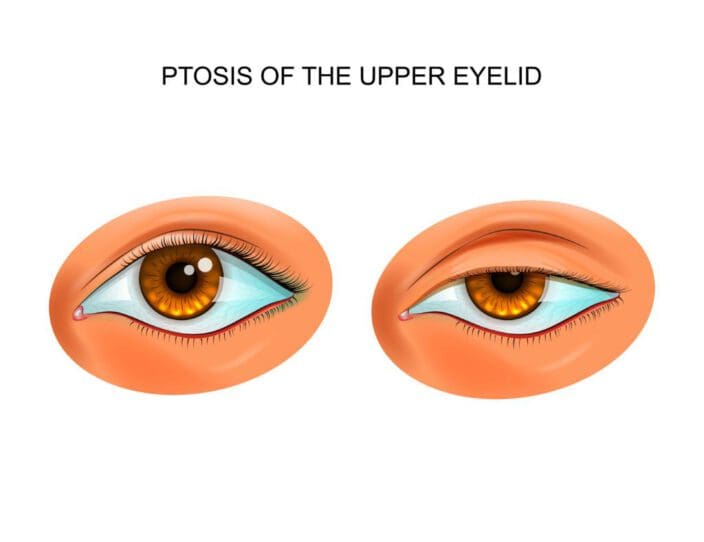Guide to Ptosis: What Is It? (& How to Treat It)
Home / Eye Conditions & Eye Diseases /
Last Updated:
When a person has ptosis, their upper eyelid involuntary closes or droops. There are different types of this condition, and both children and adults can experience it.
Table of Contents
When this condition is present, the levator muscle is affected. The muscle is not properly holding itself in the right position or moving in the correct way. Several factors can contribute to the abnormal function of this muscle, resulting in ptosis.
This condition may affect both eyelids or just one. If only one is affected, doctors can often make a diagnosis by simply looking at the differences in the person’s eyelids. If both eyelids are affected or the drooping is very subtle, further testing might be necessary to diagnose this condition.
Once a doctor makes an accurate diagnosis, they will prescribe treatment options. Surgery is among the most common. It is important to understand the potential risks of surgery before receiving treatment though.
The outlook for this condition is individualized. Once a doctor evaluates the person, they can provide a more realistic view of what they may be able to expect with treatment.

Ptosis: Symptoms & Types
When someone has ptosis, eyelid drooping is the most prominent symptom, but it is possible for other symptoms to occur too. These symptoms may include:
- Trouble blinking.
- Eye fatigue.
- Difficulty closing the affected eye.
- Crossed eyes.
- Tearing or weeping.
- Double vision.
The degree of drooping varies greatly. For some people, it may be subtle and not always noticeable. For other people, it can make it hard for them to see. In the most severe cases, the eyelid may cover the pupil entirely.
Congenital ptosis is a type that is present when someone is born. It is a rare condition that will be persistent without treatment.
While the condition is benign, it can result in cosmetic, psychological, and function problems for children. This type of ptosis can affect one or both eyes.
The other type of ptosis is acquired. There are several subtypes that fall under this category. All of these types of ptosis occur as a result of an underlying medical issue. Types of acquired ptosis include:
- Myogenic ptosis. This type occurs as a result of certain diseases, such as myasthenia gravis, congenital myopathies, and myotonic dystrophy. The levator muscle dysfunctions, which stops the eyelid from going up into the correct position.
- Aponeurotic ptosis. This type of ptosis is usually seen in elderly people. The aponeurosis of the levator muscle and the muscle itself lose tone. They then suffer the effects of gravity as a result of aging, causing an eyelid to droop.
- Mechanical ptosis. With this type, the muscles cannot raise the eyelid because it is too heavy. This may be due to orbital fat prolapse, blepharochalasis, or eyelid tumors.
- Neurogenic ptosis. This type occurs as a result of sympathetic or oculomotor nerve damage. Central nervous system damage may also cause this type of ptosis.
- Traumatic ptosis. The levator may become disinserted as a result of certain types of trauma, causing this type of ptosis.
Ptosis Causes
For some people, corrective eye surgeries or cataract surgery may cause ptosis as a complication of the procedure. If the levator muscles have a functional or anatomical abnormality, this can result in ptosis.
The most common causes of ptosis are:
You deserve clear vision. We can help.
With 135+ locations and over 2.5 million procedures performed, our board-certified eye surgeons deliver results you can trust.
Your journey to better vision starts here.
- Levator muscle weakness.
- Upper eyelid skin looseness.
- Damage to the nerves associated with the levator muscle.
Certain medical conditions may cause eyelid drooping to occur.
- Diabetes
- Myasthenia gravis
- Stye or another issue that can cause eyelid swelling
- Tumor behind or around the affected eye
- Horner syndrome
- Stroke

Diagnosing Ptosis
For some people, all a doctor will need to do is perform a physical examination. The drooping is obvious in these cases, so no further diagnostic tests are necessary. However, if the doctor suspects that a medical condition may be the underlying cause, further testing may be needed.
During the evaluation, the doctor may take photos of the person, so they can compare them in the future to determine treatment success or ptosis progression.
If further eye testing is necessary, a slit-lamp examination might be considered. The doctor usually puts a dye into the eyes and may also use another medicine to dilate the pupils. The doctor may perform this test to examine different eye structures, including the conjunctiva, eyelids, lens, cornea, iris, and sclera.
Peripheral vision loss can occur with different brain and eye disorders. Visual field testing is a way to measure someone’s peripheral vision. In most cases, the doctor has the person cover one eye. With the other eye, they focus on something in front of them. The doctor then asks them what they see on the edges of their visual field.
The Tensilon test may be considered if myasthenia gravis is the suspected cause of someone’s ptosis. For this test, the person receives the medicine Tensilon. If this drug makes the person’s muscles stronger, they have a positive Tensilon test.
Ptosis Treatment

Treatment for children and adults may differ. When determining the best treatment for kids, the doctor will consider the following:
- The age of the child
- The height of the affected eyelid
- Movements of the affected eye
- Whether the condition affects both eyelids or just one
- The eyelid muscle’s strength
Most kids will undergo surgery to improve their ptosis. This procedure may tighten the levator muscle so it functions better.
In some cases, the surgeon will bypass that muscle and attach the eyelid to another one. Ultimately, the surgeon is working to improve the child’s vision.
Some children with ptosis also have a lazy eye. If this is present, special eyeglasses or an eye patch may be prescribed. In some cases, eye drops can help this condition. The purpose is to strengthen the weaker eye.
For adults, the surgeon may do one of two procedures. The first works to tighten the levator muscle. This helps the muscle to get the eyelid into the proper position. The second procedure involves using muscles in the forehead to lift the affected eyelid. This is referred to as a sling operation, and it might be done if the levator muscle has extreme weakness.
There is a nonsurgical treatment option referred to as a ptosis crutch. This is an attachment that goes onto a person’s glasses. It holds the eyelid in place so it is no longer drooping.
There is a reinforced crutch that goes in both sides of the person’s glasses. The adjustable crutch is only on one side of the glasses. While it is best to install crutches on metal frames, they can go on almost all types of eyeglass frames.
There is no natural treatment that works for ptosis. Home remedies don’t work; medical treatments are needed.
You deserve clear vision. We can help.
With 135+ locations and over 2.5 million procedures performed, our board-certified eye surgeons deliver results you can trust.
Your journey to better vision starts here.
Potential Risks of Surgery
When someone undergoes surgery for ptosis, there is always a risk of complications or side effects that can occur once the surgery is completed. While rare, it is possible to lose movement of the eyelid that the surgeon operates on. There is also a chance that the eyelids might not look symmetrical after the surgery.
Other possible risks associated with the surgery may include a scratched cornea, dry eye, and a hematoma. A hematoma is characterized by blood collecting at the surgical site. If someone experiences dry eye, they should avoid wearing contacts until it resolves. The doctor may also prescribe tear drops to reduce associated discomfort.
It is uncommon, but infection and bleeding are risks that can happen with all surgeries. For one to two weeks after the procedure, some swelling, and bruising are possible. These are not uncommon since surgery causes trauma to the area.
Ptosis can worsen with time, remain constant, or come and go. The cause of the condition plays a major role in the expected outcome. Because of this, it is important to see a doctor as soon as possible once the drooping starts.
Frequently Asked Questions
What is ptosis?
Ptosis is present when the upper eyelid droops or closes involuntarily. The drooping can be mild, moderate, or severe.
How is ptosis corrected?
Surgery is generally needed to correct ptosis. It involves either lifting the levator muscle or tightening muscles in the forehead to lift the eye.
How much does ptosis surgery cost?
Ptosis surgery can cost between $2,000 and $6,000 out of pocket, but it is generally at least partially covered by insurance if it is deemed medically necessary.
What are the risks of ptosis surgery?
Complications from ptosis surgery are rare, but they can include hematoma, a scratched cornea, dry eye, and even loss of eye movement. Infection and bleeding are additional risks that are present with any surgery.
What is recovery from ptosis surgery like?
Full recovery can take up to three months, but the most intensive recovery period is the first week or so following surgery. You can return to normal activities as soon as you feel ready, but it’s usually recommended that you take it easy for 7 to 10 days.
You deserve clear vision. We can help.
With 135+ locations and over 2.5 million procedures performed, our board-certified eye surgeons deliver results you can trust.
Your journey to better vision starts here.
References
- Ptosis Overview. (January 2018). Verywell Health.
- Ptosis: Causes, Presentation, and Management. (May-June 2003). Aesthetic Plastic Surgery.
- Clinical Presentation and Management of Congenital Ptosis. (February 2017). Clinical Ophthalmology.
- The OD’s Guide to Ptosis Workup. (April 2020). Review of Optometry.
- Management of Ptosis. (December 2016). The Journal of Clinical and Aesthetic Dermatology.
- Slit-Lamp Exam. MedlinePlus.
- Performing the Confrontational Visual Field Exam. (2018). University of Utah.
- Edrophonium. (July 2021). STAT PEARLS.
- What Is Ptosis? (August 2018). American Academy of Ophthalmology.
- Droopy Eyelids (Ptosis). American Society of Ophthalmic Plastic and Reconstructive Surgery.
- Safety and Long-term Outcomes of Congenital Ptosis Surgery: A Population-Based Study. (June 2016). Journal of Pediatric Ophthalmology and Strabismus.
This content is for informational purposes only. It may have been reviewed by a licensed physician, but is not intended to serve as a substitute for professional medical advice. Always consult your healthcare provider with any health concerns. For more, read our Privacy Policy and Editorial Policy.
